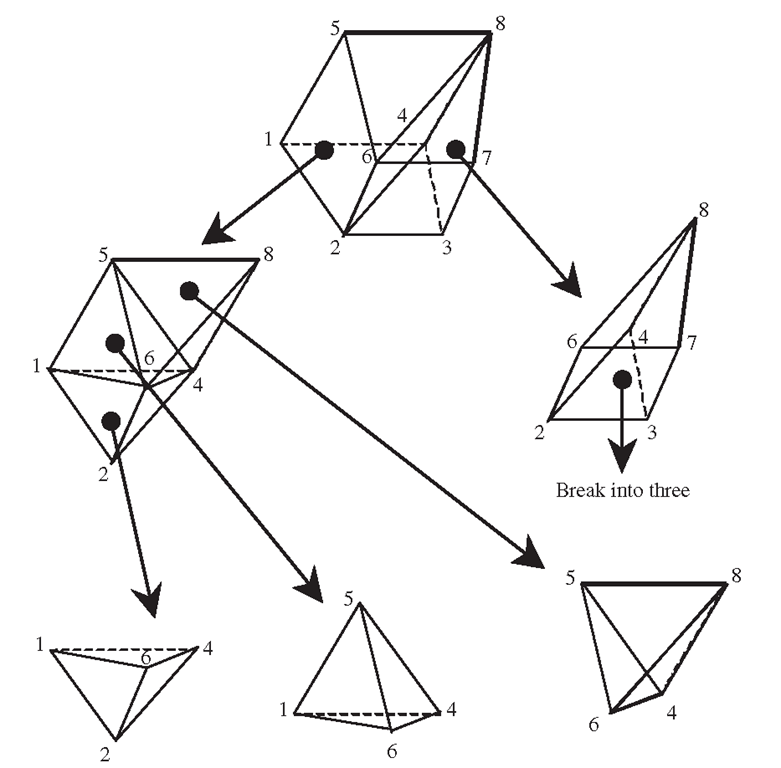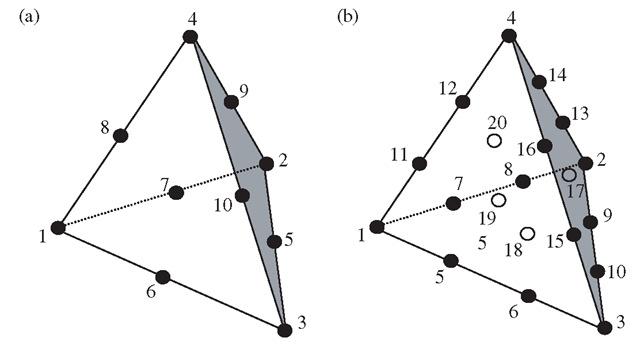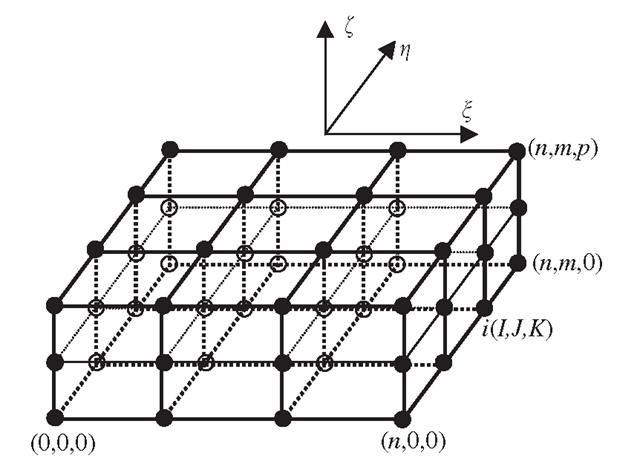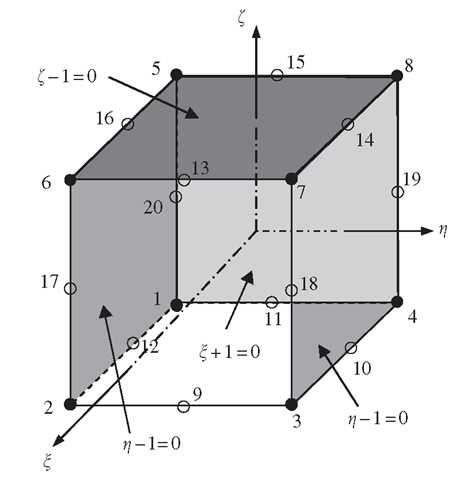Higher Order Elements
Tetrahedron Elements
Two higher order tetrahedron elements with 10 and 20 nodes are shown in Figures 9.13(a) and (b), respectively. The 10-node tetrahedron element is a quadratic element. Compared with the linear tetrahedron element (four-nodal) developed earlier, six additional nodes are added at the middle of the edges of the element. In developing the 10-nodal tetrahedron element, a complete polynomial up to second order can be used. The shape functions for this quadratic tetrahedron element in the volume coordinates are given as follows:
Figure 9.12. A hexahedron broken up into six tetrahedrons.
Figure 9.13. Higher order 3D tetrahedron elements. (a) 10-node tetrahedron element; (b) 20-node tetrahedron element.
where Li is the volume coordinate, which is the same as the shape function for the linear tetrahedron elements given by Eq. (9.15).
The 20-node tetrahedron element is a cubic element. Compared with the linear tetrahedron element (four-nodal) developed earlier, two additional nodes are added evenly on each edge of the element, and four-node central-face nodes are added at the geometry centre of each triangular surface of the element. In developing the 20-nodal tetrahedron element, a complete polynomial up to third order can be used. The shape functions for this cubic tetrahedron element in the volume coordinates are given as follows:
where Li is the volume coordinate, which is the same as the shape function for the linear tetrahedron elements given by Eq. (9.15).
Brick Elements Lagrange type elements
The Lagrange type brick elements can be developed in precisely the same manner as the 2D rectangular elements described.Consider a brick element with nd = (n + 1)(m + 1)(p + 1) nodes shown in Figure 9.14. The element is defined in the domain of![]() in the natural coordinates ξ, η and ζ. Due to the regularity of the nodal distribution along the ξ,η and ζ directions, the shape function of the element can be simply obtained by multiplying one-dimensional shape functions with respect to the ξ,η and ζ directions using the Lagrange interpolants defined in Eq. (4.82) [Zienkiewicz etal., 2000]:
in the natural coordinates ξ, η and ζ. Due to the regularity of the nodal distribution along the ξ,η and ζ directions, the shape function of the element can be simply obtained by multiplying one-dimensional shape functions with respect to the ξ,η and ζ directions using the Lagrange interpolants defined in Eq. (4.82) [Zienkiewicz etal., 2000]:
Due to the delta function property of the 1D shape functions given in Eq. (4.83), it is easy to confirm that the Ni given by Eq. (9.66) also has the delta function property.
Figure 9.14. Brick element of arbitrary high orders.
Figure 9.15. High order 3D serendipity elements. (a) 20-node quadratic element; (b) 32-node cubic element.
Serendipity type elements
The method used in constructing the Lagrange type of elements is very systematic. However, the Lagrange type of elements is not very widely used, due to the presence of the interior nodes.
Figure 9.15(a) shows a 20-nodal tri-quadratic element. The element has eight corner nodes and twelve mid-side nodes. The shape functions in the natural coordinates for the quadratic brick element are given as follows:
where![tmp5896-110_thumb[2][2] tmp5896-110_thumb[2][2]](http://what-when-how.com/wp-content/uploads/2012/06/tmp5896110_thumb22_thumb.png) are the natural coordinates of node j. It is very easy to observe that the shape functions possess the delta function property. The shape function is constructed by simple inspections, making use of the shape function properties. For example, for corner node 2 (where
are the natural coordinates of node j. It is very easy to observe that the shape functions possess the delta function property. The shape function is constructed by simple inspections, making use of the shape function properties. For example, for corner node 2 (where![tmp5896-111_thumb[2][2] tmp5896-111_thumb[2][2]](http://what-when-how.com/wp-content/uploads/2012/06/tmp5896111_thumb22_thumb.png) , the shape function N2 has to pass the following four planes as shown in Figure 9.16 to ensure its vanishing at remote nodes:
, the shape function N2 has to pass the following four planes as shown in Figure 9.16 to ensure its vanishing at remote nodes:
The shape N2 can then be immediately written as
Figure 9.16. Construction of 20-node serendipity element. Four flat planes passing through the remote nodes of node 2 are used.
where C is a constant to be determined using the condition that it has to be unity at node 2 at![tmp5896-117_thumb[2][2] tmp5896-117_thumb[2][2]](http://what-when-how.com/wp-content/uploads/2012/06/tmp5896117_thumb22_thumb.png) which gives
which gives
We finally have
which is the first equation in Eq. (9.67) for j = I.
Shape functions at all the other corner nodes can be constructed in exactly the same manner. As for the mid-side nodes, say node 9, we enforce the shape function passing through the following four planes, as shown Figure 9.17.
The shape N5 can then be immediately written as
where C is a constant to be determined using the condition that it has to be unity at node 5
We finally have
which is the third equation in Eq. (9.67) for j = 9.
Figure 9.17. Construction of 20-node serendipity element.Four flat planes passing through the remote nodes of node 2 are used.
Because the delta function property is used for the construction of shape functions given in Eq. (9.67), they of course, possess, the delta function property. It can easily be seen that all the shape functions can be formed using the following common set of basis functions:
that are linearly-independent and contain all the linear terms. From Lemmas 2 and 3, we confirm that the shape functions are partitions of unity, and at least linear field reproduction. Hence, they satisfy the sufficient requirements for FEM shape functions.
Following the similar procedure, the shape functions for the 32-node tri-cubic element shown in Figure 9.15(b) can be written as
The reader is encouraged to figure out what are the planes that should be used to form the shape functions listed in Eq. (9.77). When ζ = ζi = 1, the above equations reduce to a two-dimensional case of serendipity quadratic and cubic elements defined by Eqs. (7.107), (7.111) and (7.113).


![tmp5896-102_thumb[2][2] tmp5896-102_thumb[2][2]](http://what-when-how.com/wp-content/uploads/2012/06/tmp5896102_thumb22_thumb.png)
![tmp5896-103_thumb[2][2] tmp5896-103_thumb[2][2]](http://what-when-how.com/wp-content/uploads/2012/06/tmp5896103_thumb22_thumb.png)
![tmp5896-106_thumb[2][2] tmp5896-106_thumb[2][2]](http://what-when-how.com/wp-content/uploads/2012/06/tmp5896106_thumb22_thumb.png)


![tmp5896-109_thumb[2][2] tmp5896-109_thumb[2][2]](http://what-when-how.com/wp-content/uploads/2012/06/tmp5896109_thumb22_thumb.png)
![tmp5896-114_thumb[2][2] tmp5896-114_thumb[2][2]](http://what-when-how.com/wp-content/uploads/2012/06/tmp5896114_thumb22_thumb.png)

![tmp5896-119_thumb[2][2] tmp5896-119_thumb[2][2]](http://what-when-how.com/wp-content/uploads/2012/06/tmp5896119_thumb22_thumb.png)
![tmp5896-121_thumb[2][2] tmp5896-121_thumb[2][2]](http://what-when-how.com/wp-content/uploads/2012/06/tmp5896121_thumb22_thumb.png)
![tmp5896-122_thumb[2][2] tmp5896-122_thumb[2][2]](http://what-when-how.com/wp-content/uploads/2012/06/tmp5896122_thumb22_thumb.png)
![tmp5896-124_thumb[2][2] tmp5896-124_thumb[2][2]](http://what-when-how.com/wp-content/uploads/2012/06/tmp5896124_thumb22_thumb.png)
![tmp5896-127_thumb[2][2] tmp5896-127_thumb[2][2]](http://what-when-how.com/wp-content/uploads/2012/06/tmp5896127_thumb22_thumb.png)

![tmp5896-128_thumb[2][2] tmp5896-128_thumb[2][2]](http://what-when-how.com/wp-content/uploads/2012/06/tmp5896128_thumb22_thumb.png)
![tmp5896-129_thumb[2][2] tmp5896-129_thumb[2][2]](http://what-when-how.com/wp-content/uploads/2012/06/tmp5896129_thumb22_thumb.png)
